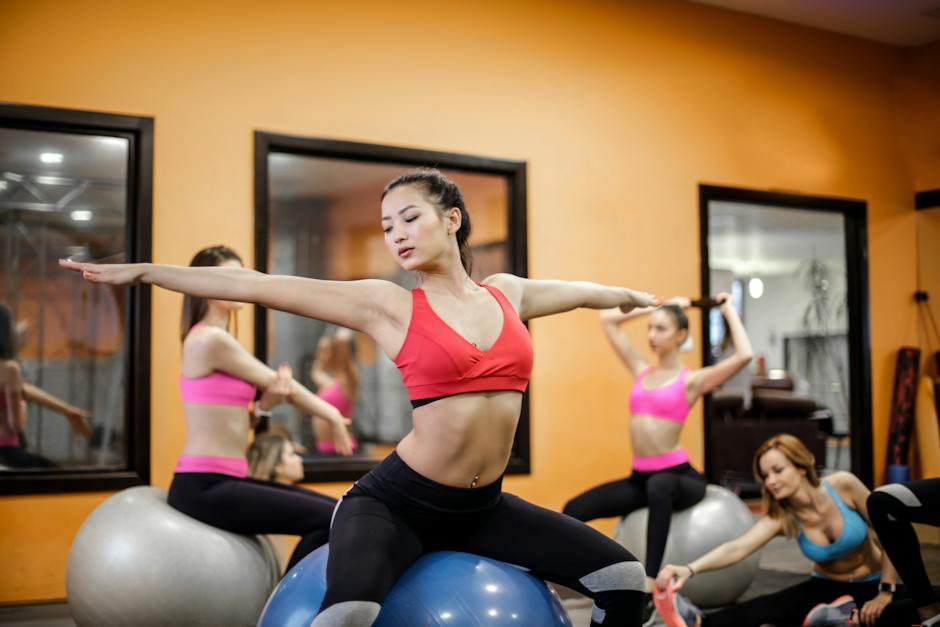
Yoga: What Fitness Benefits Does It Offer?
Yoga has become an increasingly popular form of exercise due to its ability to offer a variety of health and fitness benefits. Not only is it a low-impact exercise, but it also helps to improve overall physical and mental health, and can even help to prevent injuries. In this article, we’ll explore the various health benefits of yoga to find out why it’s become such a popular form of exercise.
List of Content
- 1. What is Yoga?
- 2. How Does Yoga Promote Physical Fitness?
- 3. Is Yoga Suitable for Everyone?
- 4. What Health Benefits Can I Expect?
- 5. What Are the Different Types of Yoga?
- 6. What Else Do I Need to Know About Practicing Yoga?
- You Ask, I answer

1. What is Yoga?
Yoga is an ancient practice from India that combines physical poses, controlled breathing, and meditation or relaxation. It originally functioned as a spiritual practice to help people gain self-enlightenment, however, in modern times it is often considered to be a form of physical exercise. Nevertheless, its spiritual roots are still an important core component of the practice.
Yoga includes different types of poses or asanas that are performed either standing, sitting or lying on the ground. These poses work to strengthen and stretch all parts of the body. Breath-work is an important part of yoga, and each pose is synchronized with a particular type of breathing pattern.
The movements and breathing exercises associated with yoga are intended to improve posture, provide strength and endurance, increase flexibility, reduce stress and tension, and create balance both physically and spiritually.
Yoga can be practised alone or in classes/ groups, and is suitable for all levels and abilities. It is usually practised wearing comfortable clothing, on a yoga mat, and with the help of props such as blankets and blocks to help support in certain poses.
- Benefits of Yoga:
- Improved posture and balance
- Increased strength and flexibility
- Reduction of stress and tension
- Improved overall wellbeing
- Disadvantages of Yoga:
- Soreness after practice
- Incorrect alignment of postures if not correctly supervised
- Can be time consuming and expensive if practised in classes

2. How Does Yoga Promote Physical Fitness?
Yoga as Strength Training
Yoga can provide just the same level of intensity as traditional strength training. The poses and postures of yoga require your muscles to work against and with your body weight. Over time, this type of resistance training helps build strength in the body. Yoga poses also help to improve your flexibility, balance and coordination, which can reduce the risk of injury if you participate in other forms of exercise.
Core Strengthening
Yoga is an excellent way to strengthen your core muscles, including your abdominal muscles, back muscles, and the muscles around the pelvis. In yoga, many of the poses involve stretching and balance which require you to engage your core muscles in order to remain balanced. Over time, the muscles in your core become stronger which can reduce back pain and help improve posture.
Cardiovascular Benefits
Yoga can also help to improve your cardiovascular health. Certain types of yoga, such as vinyasa, power yoga, and ashtanga yoga, involve moving from one pose to another in a continuous flow. This type of yoga can help get your heart rate up, boost your strength, and help you burn calories. This kind of activity can help you improve your overall cardiovascular health.
Increased Flexibility
Yoga can also help to improve flexibility. Yoga poses help to stretch the muscles in your body and increase your range of motion. This increased flexibility can benefit your overall physical fitness by helping you move more freely and efficiently. Additionally, increased flexibility can also help reduce the risk of injury when you are participating in other physical activities.
3. Is Yoga Suitable for Everyone?
Yoga is generally suitable for people of various backgrounds – from young children to seniors. However, it’s important to remember that everyone’s body is different and may require adjustments be tailored to their unique situation.
Benefits of Yoga
- Regularly practicing yoga has been shown to improve flexibility, reduce stress, help with insomnia, and even help with respiratory ailments.
- Yoga is also a low-impact workout, making it suitable for a range of fitness levels.
- The use of breath and purposeful movements with yoga have been said to improve mood and reduce depression.
Who May Need to Avoid It?
- Women who are pregnant should consult their physicians before engaging in yogic poses and activities.
- People with certain medical conditions, such as high blood pressure or heart disease, should discuss their options with their physician.
Is Yoga Safe?
Yoga is very safe when practiced properly and with guidance. It is important to start with basic poses and poses that are appropriate for your level of fitness and condition. With that said, yoga can be dangerous if not practiced correctly; pushing yourself too far or into positions that your body isn’t ready for can lead to injuries. As such, attending classes with an experienced teacher or instructor is primed to help you thrive.
4. What Health Benefits Can I Expect?
Regular Exercise
Exercise has been proven to have countless benefits for your health. It helps you maintain a healthy weight, reduce the risk of cardiovascular disease and diabetes, and strengthen muscles and bones. As a bonus, regular exercise can also improve your sleep quality and mental health.
Improved Eating Habits
Not only will regular exercise leave you feeling stronger and healthier, it can help you develop better eating habits. Studies have shown that physical activity can help people lead a healthier lifestyle, and that includes eating a healthier diet. So if you’re looking to make significant changes to your diet, then committing to regular exercise is a great first step.
Improved Immunity and Energized Body
Regular exercise can help strengthen your immune system and reduce the chances of getting sick. It also helps you maintain healthy energy levels throughout the day. When you’re physically active, your body releases hormones that help keep your brain energized and alert.
More Restful Sleep
Exercise can help you sleep better. It increases your metabolism and improves your sleep quality, allowing you to fall asleep and stay asleep longer. It also helps lower stress levels and helps you relax, increasing your chances of getting a good night’s rest.
So don’t downplay the benefits of regular exercise! Not only does it help you stay physically fit, it can also improve your mental and physical wellbeing.
5. What Are the Different Types of Yoga?
Hatha Yoga is the most popular type of yoga in the West and it encompasses a variety of postures, breathing exercises, and relaxation techniques.
Many yoga classes nowadays are Hatha-style, which combine asanas with meditation and the relaxation of the body and the mind.
Vinyasa Yoga is the most dynamic form of Hatha yoga. It emphasizes a continuous flow of movement and breath in combination with various postures and is well suited for improving flexibility. A practice can range from gentle to more intense.
Restorative Yoga is all about relaxation. Its intention is to help us let go of tension and stress, both physically and mentally, and to support healing of the body. Poses are held for a long duration and the use of props such as blankets, blocks, and bolsters is often incorporated to add comfort.
Power Yoga is another style of Vinyasa. It is a physically demanding practice that combines strength-building postures with endurance-building flows.
Kundalini Yoga is a practice focused on activating your energy through breathing exercises, postures, and meditation. It is said to awaken your inner power and self-awareness.
Iyengar Yoga emphasizes the alignment of the body in each pose and often includes the use of props to enable everyone to accurately and comfortably maintain the poses.
Bikram Yoga is a series of 26 postures and two pranayama breathing techniques. It is performed in a room heated to approximately 105°F (40.5°C) and is intended to make your body sweat.
6. What Else Do I Need to Know About Practicing Yoga?
Yoga is a marvelous way to take care of your body and mind, however there are some things to bear in mind as you embark upon your practice.
- Consistency is Key: The most beneficial way to practice yoga is regularly, as this allows you to deepen your practice and to explore further postures and variations. Aim to practice at least 3-4 times a week, and you should begin to see positive results.
- Listen to Your Body: As you proceed with your yoga practice, be sure to take it slow and pay attention to your body. It is possible to become too ambitious, which can lead to muscle strain or other injuries. Go at your own pace and rest when you need to.
Yoga can also be a spiritual practice, and it is important to remember to move with mindfulness and grace. Don’t lose patience with yourself, and rather let yourself be guided by your breath as you progress with your postures.
It is also a great idea to attend classes led by a qualified teacher. A teacher can give you important advice and guidance that its difficult to find when practising alone. Once you have the basics down you can continune with self-practice.
You Ask, I answer
Q: What is yoga?
A: Yoga is a centuries-old practice that combines physical postures with breathing techniques and meditation. It’s designed to bring harmony between the body, mind, and spirit.
Q: What are the benefits of doing yoga?
A: Practicing yoga can offer a range of potential fitness benefits, including increased flexibility, improved balance, improved posture, improved strength and endurance, improved digestion, better quality of sleep, and more mental clarity and focus.
Q: What type of yoga is best for physical fitness?
A: The best type of yoga for physical fitness varies from person to person, depending on their goals. Generally speaking, hatha yoga is a great starting point, as it emphasizes correct alignment and can be used for a gentle, relaxing practice or a more vigorous workout. Vinyasa yoga and Ashtanga yoga are two types of yoga that focus on linking breath and movement and they are often more challenging.
Q: Do I need to be flexible to do yoga?
A: Not at all. Many people begin yoga not being able to touch their toes, but with regular practice their flexibility can increase. Having said that, if you are just starting out, don’t feel like you need to force yourself. Be mindful of your own body, respect its limits, and move only as far as it feels comfortable.
The physical benefits of yoga are far reaching and long lasting, and can be taken advantage of by people of all ages and stages in life. Whether you’re looking to increase your flexibility, strengthen your muscles, reduce your stress levels, or all of the above, there is a form of yoga that can provide the answer! So why wait? Pick up a yoga mat and get into the flow!


